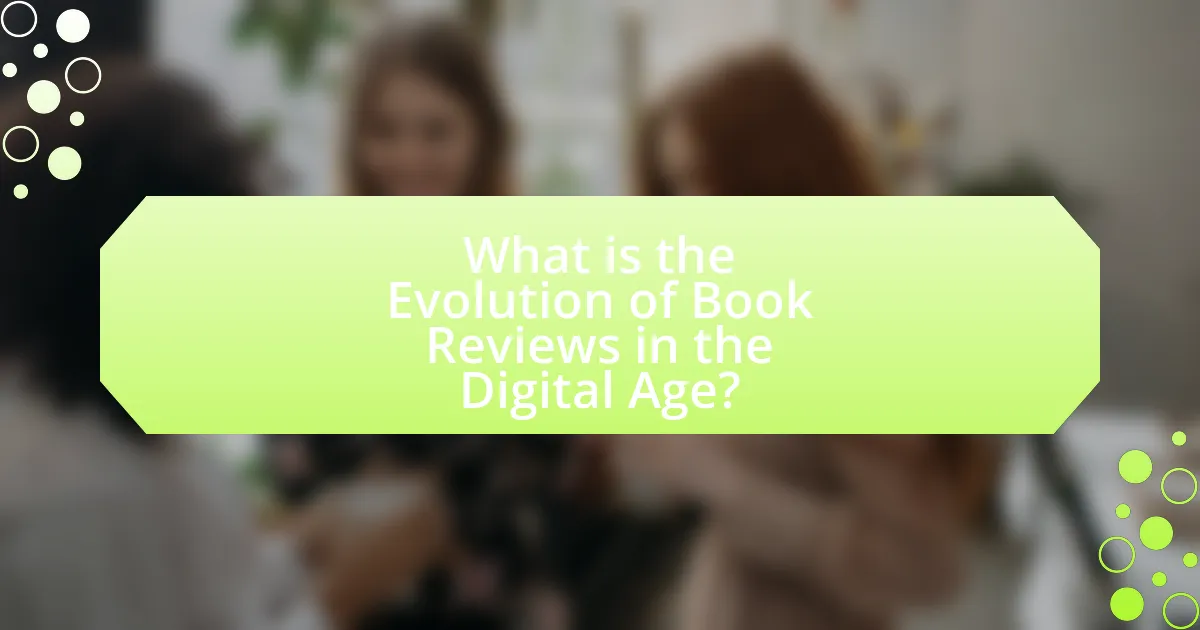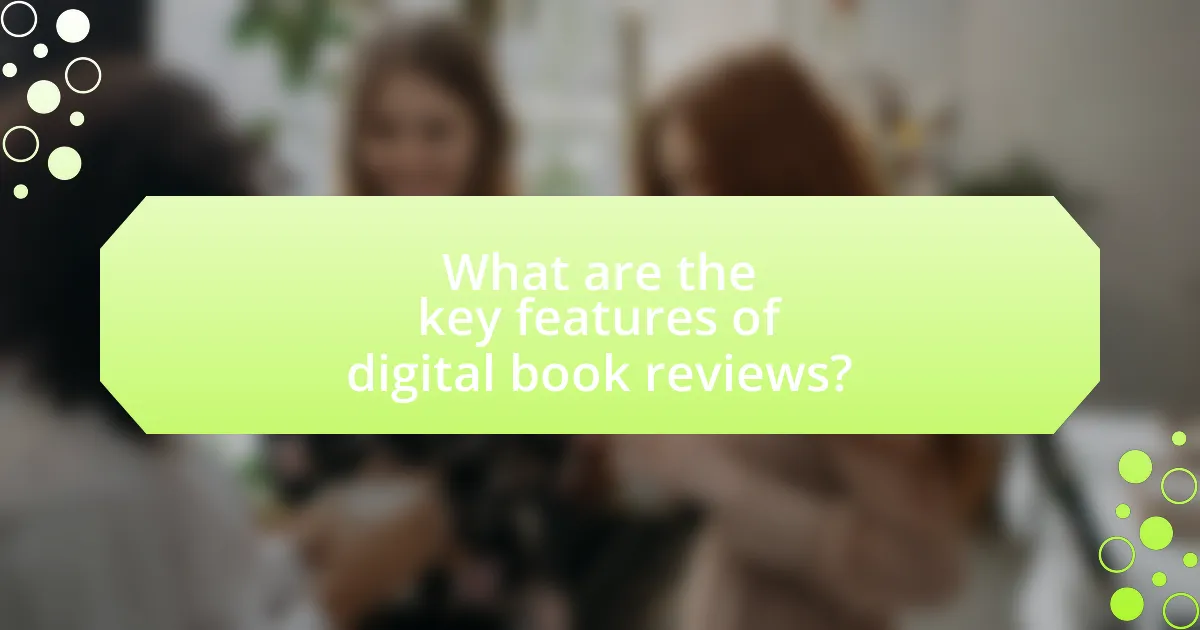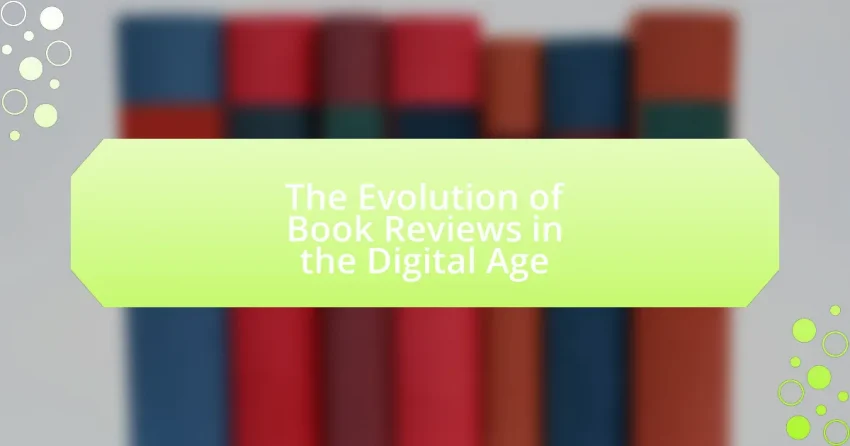The article examines the evolution of book reviews in the digital age, highlighting the transition from traditional print media to diverse online platforms. It discusses how this shift has democratized the review process, allowing for greater accessibility and user-generated content, which significantly influences reader choices and purchasing decisions. Key topics include the impact of social media on book discussions, the challenges posed by misinformation and fake reviews, and the ethical considerations that arise in digital book reviewing. The article also outlines best practices for writing effective reviews and the implications for authors and publishers in adapting to this new landscape.

What is the Evolution of Book Reviews in the Digital Age?
The evolution of book reviews in the digital age has transformed from traditional print media to diverse online platforms. Initially, book reviews were primarily published in newspapers and magazines, limiting accessibility and audience reach. With the advent of the internet, platforms like Amazon and Goodreads emerged, allowing readers to share their opinions instantly and widely. This shift democratized the review process, enabling anyone to contribute, which has led to a significant increase in the volume of reviews available. According to a 2021 report by the Pew Research Center, 79% of Americans have read a book in some form, with online reviews influencing purchasing decisions for 70% of readers. This evolution reflects a broader trend towards user-generated content, where the collective voice of readers now plays a crucial role in shaping literary discourse.
How have traditional book reviews changed with the advent of digital platforms?
Traditional book reviews have shifted significantly with the advent of digital platforms, transitioning from print media to online formats. This change has enabled a broader audience reach, allowing readers to access reviews instantly through websites, social media, and blogs. According to a 2021 survey by the Pew Research Center, 30% of U.S. adults reported reading book reviews online, highlighting the growing preference for digital content over traditional print. Additionally, digital platforms facilitate user-generated content, where readers can share their opinions and ratings, creating a more interactive and diverse review landscape compared to the previously gatekept print reviews.
What role do online platforms play in shaping book reviews?
Online platforms significantly influence the formation and dissemination of book reviews by providing accessible spaces for readers to share their opinions and experiences. These platforms, such as Goodreads and Amazon, allow users to post reviews, rate books, and engage in discussions, which democratizes the review process and enables diverse voices to be heard. Research indicates that user-generated content on these platforms can impact purchasing decisions, with studies showing that 79% of consumers trust online reviews as much as personal recommendations. This shift towards collective opinion has transformed traditional book criticism, making it more inclusive and reflective of a broader audience.
How has the accessibility of reviews impacted reader choices?
The accessibility of reviews has significantly influenced reader choices by providing immediate and diverse opinions on books. Readers can now easily access reviews from various platforms, including social media, blogs, and dedicated review sites, which allows them to make informed decisions based on a wide range of perspectives. For instance, a study by the Pew Research Center found that 82% of book readers consult online reviews before making a purchase, indicating that the availability of reviews directly correlates with consumer behavior. This shift has empowered readers to prioritize books that align with their preferences and interests, ultimately shaping the market dynamics of the publishing industry.
Why is the evolution of book reviews significant in today’s literary landscape?
The evolution of book reviews is significant in today’s literary landscape because it reflects the shift in how readers access information and make purchasing decisions. With the rise of digital platforms, traditional print reviews have been supplemented by online reviews, social media, and reader-generated content, which democratizes the review process and allows diverse voices to be heard. According to a 2021 survey by the Pew Research Center, 79% of Americans reported that online reviews influence their buying decisions, highlighting the importance of these evolving review formats in shaping public perception and sales of books. This transformation not only impacts authors and publishers but also enhances reader engagement and fosters a more interactive literary community.
What are the implications for authors and publishers?
The implications for authors and publishers in the digital age include increased visibility and accessibility of their works, as well as the necessity to engage with online platforms for marketing and feedback. Authors can leverage social media and review sites to reach broader audiences, while publishers must adapt their strategies to include digital marketing and online distribution channels. The rise of user-generated content and online reviews can significantly influence sales and reputation, making it essential for both authors and publishers to actively manage their online presence and respond to reader feedback. This shift is supported by data showing that 79% of consumers trust online reviews as much as personal recommendations, highlighting the importance of digital engagement in the current literary landscape.
How do changes in book reviews reflect broader cultural shifts?
Changes in book reviews reflect broader cultural shifts by showcasing evolving societal values, preferences, and concerns. For instance, the rise of diverse voices in literature and the increasing emphasis on representation in book reviews indicate a cultural shift towards inclusivity and social justice. This is evidenced by the growing number of reviews that highlight works by authors from marginalized communities, which aligns with movements advocating for equity and representation in various sectors. Additionally, the transition from traditional print reviews to digital platforms has democratized the review process, allowing for a wider range of opinions and fostering a culture of dialogue and critique that mirrors contemporary societal dynamics.

What are the key features of digital book reviews?
Digital book reviews primarily feature accessibility, interactivity, and multimedia integration. Accessibility allows readers to easily find and read reviews online, often through platforms like Goodreads or Amazon, where millions of reviews are available. Interactivity enables users to engage with the content by leaving comments, rating reviews, and sharing their own opinions, fostering a community of readers. Multimedia integration enhances the review experience by incorporating images, videos, and audio, which can provide deeper insights into the book’s themes and content. These features collectively transform how readers discover and evaluate books in the digital landscape.
How do social media platforms influence book reviews?
Social media platforms significantly influence book reviews by amplifying reader opinions and facilitating immediate feedback. These platforms allow users to share their thoughts on books widely, leading to increased visibility for both positive and negative reviews. For instance, a study by the Pew Research Center found that 72% of adults use social media, which enables them to engage with book content and share reviews, impacting the purchasing decisions of their followers. Additionally, algorithms on platforms like Instagram and Goodreads promote popular reviews, further shaping public perception and trends in reading.
What are the most popular social media platforms for book discussions?
The most popular social media platforms for book discussions are Goodreads, Facebook, and Instagram. Goodreads is specifically designed for readers to share reviews, track reading progress, and participate in discussions through groups and forums. Facebook hosts numerous book clubs and groups where users can engage in discussions about various genres and authors. Instagram, particularly through the use of hashtags like #Bookstagram, allows users to share book-related content and connect with fellow readers through visual storytelling and recommendations. These platforms collectively facilitate vibrant communities centered around literature and reading.
How do user-generated reviews compare to professional critiques?
User-generated reviews often provide a broader range of perspectives compared to professional critiques, which tend to be more analytical and structured. User-generated reviews reflect personal experiences and opinions, allowing for diverse insights that may resonate with a wider audience. In contrast, professional critiques typically rely on established criteria and expertise, offering in-depth analysis and context that can enhance understanding of the work. Research indicates that 79% of consumers trust online reviews as much as personal recommendations, highlighting the influence of user-generated content. Additionally, a study by BrightLocal found that 91% of consumers read online reviews, suggesting that user-generated reviews significantly impact purchasing decisions and perceptions of credibility.
What technological advancements have impacted book reviews?
Technological advancements such as the rise of the internet, social media platforms, and mobile applications have significantly impacted book reviews. The internet has enabled instant access to a vast array of reviews, allowing readers to share their opinions on platforms like Goodreads and Amazon, which collectively host millions of user-generated reviews. Social media platforms, including Twitter and Instagram, facilitate real-time discussions and recommendations, influencing public perception and sales of books. Additionally, mobile applications provide convenient access to reviews and allow users to write and post their own reviews directly from their devices, further democratizing the review process. These advancements have transformed how readers discover, evaluate, and engage with books, making reviews more accessible and influential than ever before.
How do algorithms affect the visibility of book reviews?
Algorithms significantly influence the visibility of book reviews by determining which reviews are prioritized in search results and recommendation systems. These algorithms analyze various factors, such as user engagement, relevance, and recency, to rank reviews, thereby affecting their exposure to potential readers. For instance, platforms like Amazon and Goodreads utilize algorithms that favor reviews with higher ratings and more interactions, ensuring that these reviews appear more prominently. This prioritization can lead to a skewed perception of a book’s quality, as reviews that align with algorithmic preferences gain more visibility, while others may remain unnoticed.
What tools are available for readers to share their reviews?
Readers can share their reviews using various online platforms and tools, including social media sites, dedicated book review websites, and blogging platforms. Social media platforms like Facebook, Twitter, and Instagram allow users to post reviews and engage with other readers. Websites such as Goodreads and Amazon provide specific sections for users to write and share their reviews, often with rating systems that enhance visibility. Additionally, blogging platforms like WordPress and Medium enable readers to publish detailed reviews and reach wider audiences. These tools facilitate the sharing of opinions and experiences, contributing to the broader conversation about books in the digital age.

What challenges do book reviews face in the digital age?
Book reviews in the digital age face several challenges, including information overload, credibility issues, and the impact of algorithms on visibility. The vast amount of content available online can overwhelm readers, making it difficult for them to discern valuable reviews from less credible ones. Additionally, the rise of self-publishing has led to an influx of reviews, some of which may lack authenticity or expertise, further complicating the landscape. Algorithms used by platforms often prioritize certain reviews based on engagement metrics rather than quality, which can skew public perception and limit exposure for well-written critiques. These factors collectively hinder the effectiveness and reliability of book reviews in the current digital environment.
How has the rise of misinformation affected book reviews?
The rise of misinformation has significantly undermined the credibility of book reviews. As false information proliferates online, readers often struggle to discern genuine reviews from manipulated or biased ones, leading to confusion and mistrust in the review process. A study by the Pew Research Center in 2020 found that 64% of Americans believe that misinformation has caused confusion about basic facts, which extends to the realm of literature, where misleading reviews can skew public perception and sales. Consequently, authors and publishers face challenges in promoting their works, as potential readers may rely on inaccurate reviews that misrepresent the content or quality of books.
What strategies can readers use to identify credible reviews?
Readers can identify credible reviews by evaluating the reviewer’s expertise, checking for detailed and balanced content, and looking for corroboration across multiple sources. Expertise can be assessed by examining the reviewer’s background, such as their familiarity with the genre or author. Detailed reviews that discuss specific elements of the book, such as character development and plot structure, indicate a thoughtful analysis rather than a superficial opinion. Additionally, corroboration from multiple credible sources, including professional critics and reputable platforms, enhances the reliability of the review. These strategies help readers discern quality insights from potentially biased or unqualified opinions.
How do fake reviews impact authors and readers alike?
Fake reviews negatively impact authors by distorting their reputation and sales, while also misleading readers in their purchasing decisions. Authors may experience a decline in credibility and financial loss due to inflated or deflated ratings that do not accurately reflect the quality of their work. For instance, a study by the University of California, Berkeley, found that fake reviews can significantly alter consumer behavior, leading to a 20% increase in sales for products with positive fake reviews. Readers, on the other hand, may waste time and money on books that do not meet their expectations, as they rely on reviews to guide their choices. This creates a cycle of mistrust in the review system, ultimately harming both authors and readers in the digital marketplace.
What ethical considerations arise in digital book reviewing?
Ethical considerations in digital book reviewing include issues of transparency, bias, and authenticity. Reviewers must disclose any conflicts of interest, such as receiving free copies from publishers, to maintain credibility. Additionally, the potential for bias arises when reviewers have personal relationships with authors or publishers, which can compromise the objectivity of their assessments. Authenticity is also crucial; reviews should reflect genuine opinions rather than being influenced by external pressures or incentives. These considerations are essential for fostering trust in the digital book reviewing landscape, as evidenced by the rise of guidelines from organizations like the American Library Association, which emphasizes ethical standards in literary criticism.
How do conflicts of interest manifest in online reviews?
Conflicts of interest in online reviews manifest primarily through biased endorsements or negative critiques influenced by personal or financial relationships. For instance, authors may solicit positive reviews from friends or family, leading to inflated ratings that misrepresent the book’s quality. Additionally, companies may pay reviewers or incentivize them with free products, creating a scenario where the reviewer’s impartiality is compromised. Research indicates that approximately 30% of online reviews may be influenced by such conflicts, undermining the credibility of the review system and misleading potential readers.
What guidelines should reviewers follow to maintain integrity?
Reviewers should adhere to guidelines that emphasize honesty, objectivity, and transparency to maintain integrity. This includes providing unbiased evaluations based on the content rather than personal preferences or relationships with authors. Reviewers must disclose any conflicts of interest, such as financial ties or personal connections to the work being reviewed, to ensure transparency. Additionally, they should avoid plagiarism by properly attributing ideas and quotes to their original sources. Following these guidelines helps uphold the credibility of the review process and fosters trust among readers and authors alike.
What are best practices for writing effective digital book reviews?
Effective digital book reviews should be concise, informative, and engaging. To achieve this, reviewers should start with a brief summary of the book’s plot and main themes, providing context for potential readers. Following the summary, reviewers should express their personal opinions, highlighting what worked well and what did not, supported by specific examples from the text. Additionally, using a clear structure, such as dividing the review into sections for summary, analysis, and conclusion, enhances readability. Incorporating relevant comparisons to similar works can also provide valuable insights. Finally, maintaining a respectful tone, even when critiquing, fosters a positive reading community.
How can reviewers engage their audience effectively?
Reviewers can engage their audience effectively by utilizing interactive content, such as polls and discussion prompts, to foster participation. This approach encourages readers to share their opinions and experiences, creating a sense of community. Research indicates that interactive elements can increase audience engagement by up to 70%, as they invite direct involvement and feedback. Additionally, incorporating multimedia elements like videos and images can enhance the review experience, making it more appealing and relatable.
What elements should be included in a comprehensive book review?
A comprehensive book review should include a summary of the book’s content, an analysis of its themes, an evaluation of the author’s writing style, and a discussion of the book’s strengths and weaknesses. The summary provides an overview of the plot and main ideas, while the analysis delves into the underlying messages and themes presented by the author. Evaluating the writing style assesses the effectiveness of the author’s language and narrative techniques. Finally, discussing strengths and weaknesses offers a balanced perspective on the book’s overall impact and relevance. These elements ensure that the review is informative, critical, and engaging for potential readers.
